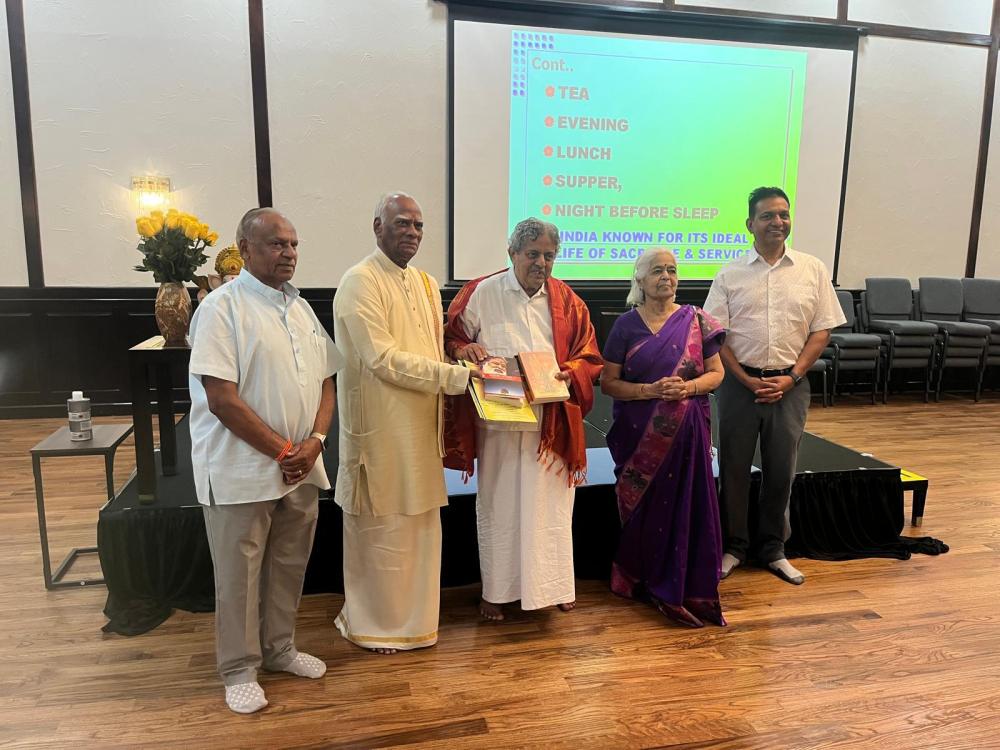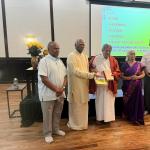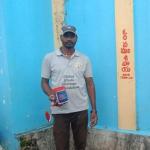Global Hindu Heritage Foundation
14726 Harmony Lane, Frisco, Texas 75035
Email: ghhfusaorg@gmail.com; Phone +1 601-918-7111
September 9, 2025
Honorable Sri Pawan Kalyan
Deputy Chief Minister, Andhra Pradesh
Velagapudi, Andhra Pradesh.
Dear Sir
Sub: Varahi Declaration is contrary to Tablighi Izithima: Request you to cancel the granted permission to organize a gathering near Tirupati
Global Hindu Heritage Foundation is opposed to the granting of permission to conduct Tablighi Izithima in Agalarala Village in Chandra Mandala in Tirupati District.
We request that your office examine the mission of Tablighi, find out what the Quran says about non-believers, idol worshippers, kinds of sins, the intensity of hell imposed on non-believers from the Quran, since the Petition says that they are conducting the Tablighi, praying Allah to forgive sins, and accord global peace.
How can this organization say that they are conducting this gathering to forgive sins, when Allah clearly states that idol worship is the greatest sin ever committed by any man?
This Tablighi Jamaat is a cover to recruit more Muslims to aggressive jihad and remind them of Allah’s command to kill all the non-believers and idol worshippers.
Varahi Declaration: How Tablighi is contradictory to the Varahi Declaration
Global Hindu Heritage Foundation was pleased to hear the speech on October 3, 2024, as it championed the cause of Hinduism.
Let us remember some of your noncontroversial statements to protect Sanatana Dharma:
• If anyone tries to wipe out Santana Dharma, let me tell you from the feet of Lord Balaji, you will be wiped out."
• Advocated for the need for nationwide legislation to safeguard Sanatana Dharma
• Mission aimed at defending the cultural and religious heritage of Andhra Pradesh
• It represents the spirit of our culture and the unwavering commitment to protect our state.
• Now, VARAHI returns for a much bigger mission. The mission is to echo the voice of millions who wish to bring “Sanatana Dharma Raksha Board” to life."
• Defend Sanatana Dharma against actions or statements that harm its core beliefs.
• Advocates disengaging with individuals or groups that promote hatred or defame Sanatana Dharma.
Your noble ideology to protect Sanatana Dharma without harming any other groups or faiths is appreciated. The declaration stands for the protection of Sanatana Dharma and maintaining the integrity of Bharat.
Unfortunately, the two Abrahamic religions have nothing to do with the philosophy you clearly stated in the Varahi Declaration. They challenge our existence. They are converting Hindus with deception and allurement. They are multiplying their numbers with no limit solely for the purpose of infiltrating the country and undermining the democracy, attacking our Temples, demeaning our Gods, breaking up idols, and killing non-Muslims.
What is the Mission of Tablighi?
Let us look at the mission of Tablighi Izithima. It means  'Gathering of Preachers', also translated as "propagation party" or "preaching party.” Tablighi Jamaat was started with a mission to follow the teachings of the Quran and Hadith.
• It encourages fellow members to return to practice their religion according to the teachings of the Islamic prophet Muhammad, and secondarily give dawah (calling) to non-Muslims.
• Also, to remind Muslims to preach “the core teachings of the Prophet Muhammad" and encourage them to attend mosque prayers and sermons.
• Every action must please Allah and reform oneself. Any slightest deviation from this set path is bound to generate the wrath and anger of Allah instead of admitting a partner in that deed.
That means that this organization is committed to following the teachings of Allah as referenced in the Quran. Let us examine what the Quran says and what Ahle Sunnah Wal Jamath Lababeen Jamia Masjid Trust. The purported reason given by the Masjid Trust, which is to forgive sins, is contradictory to what is written in the Quran. That means they are not revealing the actual reason for conducting this Tablighi. This gathering is intended solely to mislead the government and the public regarding the actual reason. They are hiding the real reason for this gathering.
The teachings of the Quran are contradictory to the Sanatana Dharma philosophy.
The CONNECTION between Tablighi and Terrorism
Fred Burton, Scott Stewart, Mumtaz Ahmad, and Shireen Khan Burki explained the connection between Tablighi Jamaat and jihadism by the opinion that.
They "share the same core ideology and ultimate objectives (the expansion of Dar al Islam and the establishment of a global Caliphate)".
Thus, Tablighi Jamaat provides "a cover, a conduit and a fertile recruiting ground for jihadi organizations such as Al Qaeda and Lashkar-i-Taiba".[86] TJ has been said to enable Al-Qaida "by supporting recruitment in radical madrassas and fundraising at mosques all over Pakistan.
According to Alex Alexiev, "perhaps 80% percent of the Islamist extremists have come from Tablighi ranks, prompting French intelligence officers to call Tablighi Jamaat the 'antechamber of fundamentalism.
According to Patrick Sukhdeo, TJ is a highly secretive group, and the core of the group does not disclose how it operates. Despite claims of being apolitical, it has ties with the political and military sectors of countries such as Pakistan and Bangladesh.
The Tablighi Jamaat tried to expand the Abbey Mills Mosque into the largest mosque in the United Kingdom. The plan attracted controversy, and the Tablighi was denied permission.
Kill the Non-believers and Idol worshippers.
‘O mankind! Truly, I am a Messenger to you all from Allah to Whom belongs the Kingdom of the heavens and the earth. There is no God but He. He gives life and He causes death…” (Ch. 7: verse159)
Quran 9:5: “And when the sacred months have passed, then kill the polytheists wherever you find them and capture them and besiege them and sit in wait for them at every place of ambush.
There are several verses written in the Quran. Please be acquainted with the Quran verses to understand the reasons behind their request to conduct Tablighi Izithima.
Global Peace is anathema to Muslims.
The organizers mentioned in the latter that they are organizing this Tablighi Izithima for global peace and universal brotherhood. Islam stands for no peace, no tolerance, and no universal brotherhood. History tells us that Islam has expanded primarily through conquest, ethnic cleansing, political dominance, and demographic shifts, often leading to the Islamization of many in the Middle East.
Nearly eight centuries of Islamic rule in India resulted in the death of more than 50 million, as documented by Professor K. S. Lal. Untold misery was inflicted on the Hindu population. They destroyed all major Hindu Temples such as Kasi Viswanath Temple, Ayodhya Rama Temple, and Mathura Krishna Temple.
Will Durant, the famous historian, summed up the target as follows:
“The Islamic conquest of India is probably the bloodiest story in history. It is a discouraging tale, for its evident moral is that civilization is a precious good, whose delicate complex of order and freedom, culture and peace, can at any moment be overthrown by barbarians invading from without or multiplying within."
Now the unfinished business of Muslims is to conquer India. It is their mission and goal. They are not hiding their intention to make India an Islamic country.
The most sacred place for Hindus is Tirumala, the abode of Lord Venkateswara. Muslims plan to flood their people into the Tirupati area and change the demography. Whatever they have done to other most sacred places, they are determined to take over the holy city and affect the sanctity of Lord Venkateswara.
Global Hindu Heritage Foundation requests the Andhra Pradesh government to follow:
1) to cancel the permission granted to organize Tablighi Izithima on September 13 and 14 near Tirupati.
2) Monitor the terrorist activities all across the State
3) Monitor the Muslim activities on the Tirumala Hills as seen by a Muslim doing Namaz
4) Monitor the inflow of undocumented Muslims from other countries entering Andhra Pradesh.
Every Hindu proudly remembers your statement that you will sacrifice your life to protect Sanatana Dharma. This presents a golden opportunity to safeguard the sanctity of Tirumala-Tirupati. Why do they want to organize near Tirupati, but not any other place? As you may have guessed, they want to tarnish the sacred image of Lord Venkateswara and create fear among Hindus. This is a ploy to take over Tirupati, the fourth sacred place on earth for Hindus.
As you are aware, they have destroyed the Kasi Vishwanath Temple, the Mathura Krishna Temple, and the Rama Temple in Ayodhya.
Now it is their turn to destroy the Temple town of Tirupati, which is their unfinished business.
Thus, we earnestly request that you cancel the permit granted to the Tablighi Jamaat gathering on September 13 and 14, 2025.
Sincerely
Prakasarao Velagapudi PhD
President, Global Hindu Heritage Foundation
Copy to Sri Chandrababu Naidu, CM
Copy to Sri B R Naidu, TTD Board Chairman
Copy to the Commissioner, Municipal Corporation, Tirupati
Copy to the Deputy Superintendent of Police, Tirupati
Copy to the Inspector of Police, Chandra Giri, Tirupati District.
09 Sep 2025















 Urgent support needed for Bangladesh Hindus
Urgent support needed for Bangladesh Hindus 



